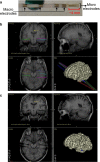Single-cell recordings in the human medial temporal lobe
- PMID: 25163775
- PMCID: PMC4580099
- DOI: 10.1111/joa.12228
Single-cell recordings in the human medial temporal lobe
Abstract
Recordings from individual neurons in patients who are implanted with depth electrodes for clinical reasons have opened the possibility to narrow down the gap between neurophysiological studies in animals and non-invasive (e.g. functional magnetic resonance imaging, electroencephalogram, magnetoencephalography) investigations in humans. Here we provide a description of the main procedures for electrode implantation and recordings, the experimental paradigms used and the main steps for processing the data. We also present key characteristics of the so-called 'concept cells', neurons in the human medial temporal lobe with selective and invariant responses that represent the meaning of the stimulus, and discuss their proposed role in declarative memory. Finally, we present novel results dealing with the stability of the representation given by these neurons, by studying the effect of stimulus repetition in the strength of the responses. In particular, we show that, after an initial decay, the response strength reaches an asymptotic value after approximately 15 presentations that remains above baseline for the whole duration of the experiment.
Keywords: declarative memory; medial temporal lobe; repetition suppression; single cell recordings in humans.
© 2014 The Authors. Journal of Anatomy published by John Wiley & Sons Ltd on behalf of Anatomical Society.
Figures








References
-
- Babb TL, Carr E, Crandall PH. Analysis of extracellular firing patterns of deep temporal lobe structures in man. Electroencephalogr Clin Neurophysiol. 1973;34:247–257. - PubMed
-
- Burwell RD, Agster KL. Anatomy of the hippocampus and the declarative memory system. In: John HB, editor. Learning and Memory: A Comprehensive Reference. Oxford: Academic Press; 2008. pp. 47–66.
-
- Eichenbaum H. The hippocampus and declarative memory: cognitive mechanisms and neural codes. Behav Brain Res. 2001;127:199–207. - PubMed
-
- Eichenbaum H. Hippocampus: cognitive processes and neural representations that underlie declarative memory. Neuron. 2004;44:109–120. - PubMed
Publication types
MeSH terms
Grants and funding
LinkOut - more resources
Full Text Sources
Other Literature Sources
Medical
Miscellaneous

